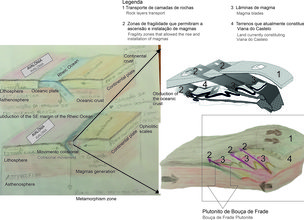UNDERGROUND MAGMA TONGUE
Montedor hill is a granitic mass, which results from the overflow of a magma sheet from the main magmatic pocket of Bouça de Frade. The collision between the continents Gondwana and Avalonia-Laurentia, which took place between the Devonian and the lower Carbonic between 400 to 290 million years ago (Paleozoic Era) was the event responsible for the genesis of this plutonite, which together with those of Sta. Luzia and Afife, form the mountains of Sta. Luzia and Caminha (antiform of Viana do Castelo-Caminha).
The rise and installation of the Bouça de Frade magma, processes that took place between 5 to 7 km in depth, took place in the context of a collision between the continents Gondwana and Avalonia-Laurentia, was also responsible for the transport (carrying) of rocks layers from the margin and the ocean floor from the primitive Rheic Ocean to the East and on the lands that today constitute Viana do Castelo. As a result of this transport process, areas of fragility developed between the moving layers, which allowed the escape of magma (Carvalhido, 2012).
References:
Carvalhido (2012). O Litoral Norte de Portugal (Minho-Neiva): evolução paleoambiental quaternária e proposta de conservação do património geomorfológico. Tese de Doutoramento, Universidade do Minho, 564 p.
Montedor hill is a granitic mass, which results from the overflow of a magma sheet from the main magmatic pocket of Bouça de Frade. The collision between the continents Gondwana and Avalonia-Laurentia, which took place between the Devonian and the lower Carbonic between 400 to 290 million years ago (Paleozoic Era) was the event responsible for the genesis of this plutonite, which together with those of Sta. Luzia and Afife, form the mountains of Sta. Luzia and Caminha (antiform of Viana do Castelo-Caminha).
The rise and installation of the Bouça de Frade magma, processes that took place between 5 to 7 km in depth, took place in the context of a collision between the continents Gondwana and Avalonia-Laurentia, was also responsible for the transport (carrying) of rocks layers from the margin and the ocean floor from the primitive Rheic Ocean to the East and on the lands that today constitute Viana do Castelo. As a result of this transport process, areas of fragility developed between the moving layers, which allowed the escape of magma (Carvalhido, 2012).
References:
Carvalhido (2012). O Litoral Norte de Portugal (Minho-Neiva): evolução paleoambiental quaternária e proposta de conservação do património geomorfológico. Tese de Doutoramento, Universidade do Minho, 564 p.

Plutonite of Bouça de Frade installation layout, adapted from Pamplona & Ribeiro (2013)
Location
Carreço
Coordinates
Lat: 41.7460216
Long: -8.8770977
Hello little one!
I'm Piquinhos and I can help you learn more about the Geopark!
Technical details
UNDERGROUND MAGMA TONGUE
At the end of the second deformation phase, Bouça de Frade plutonite is installed. This intrusion is associated with inverse shearing, which conditioned the laminar morphology (to the west) of said plutonites. The referenced ascent and installation mechanism provide for the combined action of diffuse (pervasive) migration of felsic magma to the mesoscale and tangential tectonics to the East (carriage to the East of the allochthonous units), which generated inverse shear with westward vergence.
References and scientific articles
Pamplona, J., & Ribeiro, A. A. R. (2013). Evolução geodinâmica da região de Viana do Castelo (Zona Centro-Ibérica, NW de Portugal).
Plutonite of Bouça de Frade installation layout, adapted from Pamplona & Ribeiro (2013)
Child Mode
Discover the geopark in a simpler format, aimed at the little ones.
Clique ENTER para pesquisar ou ESC para sair